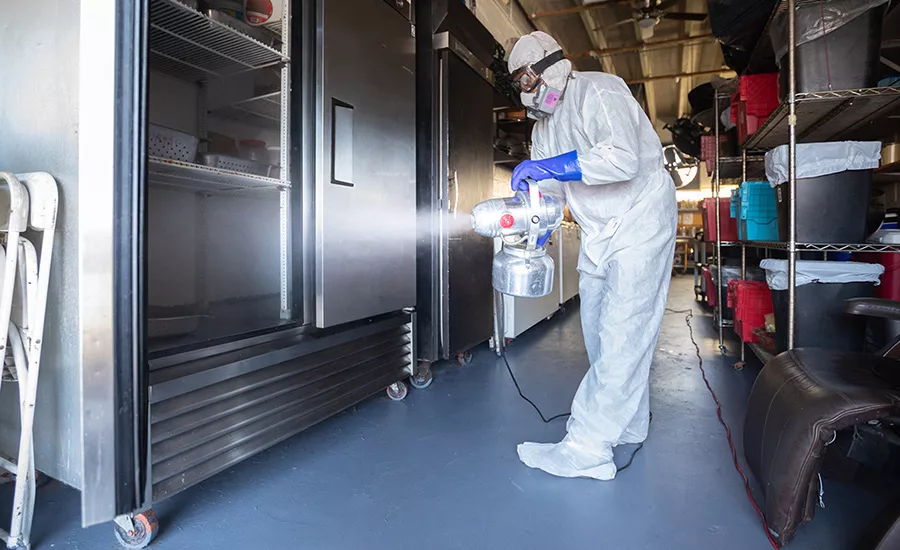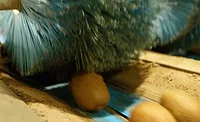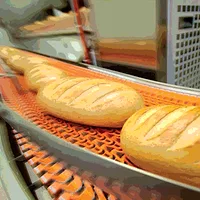The Rise of Antimicrobial Coatings Usage and Standards
A renewed interest in the use of antimicrobial coatings in the food sector has been observed with the COVID-19 pandemic

Image credit: THEPALMER/E+ via Getty Images
With the onset of the COVID-19 pandemic, all industries that need to maintain microbiologically safe environments have shown a renewed interest in antimicrobial coatings and their application. This is evidenced by the number of scientific, industry-related, and regulatory agency publications since 2020. A significant increase has also been seen in the number of companies that develop, manufacture, and sell these products. Antimicrobial coatings are being used in the food sector, primarily in food processing, dairy, and large-scale production, as well as in the utensils and containers used in these processes.
More recently, antimicrobial coatings are being used in ready-to-eat deli meat packaging. The regulatory community has observed as antimicrobial coatings and antimicrobial surfaces have been introduced into the retail food marketplace. These products are being used in both public and food production areas as an adjunct to regular sanitation protocols, with little guidance and virtually no background information, with the exception of the product labeling.
To better understand these new and novel products and their applications, a brief review and introduction to current informational resources is presented. Antimicrobial coatings and surfaces have several characteristics in common. Those used with food and in food-related applications have additional characteristics and regulatory requirements. The present and future market drivers for these products are well summarized in a July 2020 article.1
Antimicrobial Coatings Development
Basically, an antimicrobial coating is an application of a chemical agent on a surface that can stop or retard the growth of disease-causing microorganisms, as well as allergens. Apart from increasing the surface's durability, appearance, corrosion resistance, and cleanability, these coatings and surfaces may also protect from harmful, disease-causing microbes. Antimicrobial coatings reduce the need for harsh cleaning agents and the overuse of sanitizers and disinfectants.
Surfaces are usually designed by impregnation of materials with biocides that are released into the surroundings, killing microbes. The most common actives used to manufacture antimicrobial coatings include various isothiazolinone treatments, zinc pyrithione, silver, copper, and quaternary ammonium compounds. Antimicrobial polymers are a new class of disinfectants that can be used even as an alternative to antibiotics, in some cases, such as medical implants where the restriction of microbiological growth is needed in an anaerobic or microaerophilic environment.
The industry foresees wider applications of these products to include food contact surfaces. A comprehensive insight into the science of antimicrobial polymeric coatings, surface topography, surface chemistry, monolithic coatings, and polymer-based composites is presented in an October 2020 article.2
Looking for quick answers on food safety topics?
Try Ask FSM, our new smart AI search tool.
Ask FSM →
Standards Governing Coatings Use
The U.S. Environmental Protection Agency (EPA) requires that manufacturers of antimicrobial coatings demonstrate destruction of 99.9 percent of selected microbes on surfaces, including those that cause disease, in order to sell their products. Unfortunately, there is no specific single test (such as those by which sanitizers and disinfectants are evaluated) to prove the efficacy of antimicrobial coatings. However, several test methods have been developed by the American Society for Testing and Materials (ASTM), the American Association of Textile Chemists and Colorists (AATCC), the Japanese Industrial Standard (JIS), and the International Organization for Standardization (ISO), to help gauge the performance of an antimicrobial coating in combatting the growth and survival of microbes. Of these, EPA recommends the use of two methods to evaluate biofilm claims:
- ASTM E3161-18: "Standard Practice for Preparing a Pseudomonas aeruginosa or Staphylococcus aureus Biofilm using the CDC Biofilm Reactor"
- ASTM E2871-19: "Standard Test Method for Determining Disinfectant Efficacy against Biofilm Grown in the CDC Biofilm Reactor using the Single Tube Method."
Existing EPA regulations do not allow these products to be sold with unsubstantiated claims, such as the promise of inhibiting disease transmission. This places the responsibility for the validation of such claims on the purchaser.
Additionally, in its final rule clarifying data requirements for antimicrobial pesticides in 40 CFR Part 158 Subpart W (158W), EPA states that if pesticide residues found on food resulting from the use of antimicrobial pesticides on food contact surfaces are 200 ppb or less, then EPA requires a certain set of toxicology data to be submitted when these coatings are used on or in food contact surfaces. If residues are greater than 200 ppb, then additional data may be required, depending on other conditions such as test results. The final rule also clarifies that the referenced 200-ppb level is based on total estimated daily dietary intake rather than on the amount of residue present on a single commodity. This interpretation is consistent with the U.S. Food and Drug Administration's (FDA's) policy. In its 2002 guidance policy, FDA includes requirements for a safety summary and comprehensive toxicological profile: safety testing recommendations for food contact substances and their constituents, and evaluation of structural similarities to known toxicants.
Not mentioned in the resource literature available online are two additional, excellent resources. The first is NSF/ANSI 2 (2019): Food Equipment. This standard establishes minimum food protection and sanitation requirements for the materials, design, fabrication, construction, and performance of food handling equipment. While it does not speak to antimicrobial coatings, it details the smoothness of angles and corners in a food zone; the usage of fasteners, latches, and hinges; and the cleanability of various components for sanitation. In its Informative Annex 4, the standard provides a guide to zone designation (Food Zone, Splash Zone, and Nonfood Zone) to better understand where the application of an antimicrobial coating would be most effective and economically viable.
The second standard is NSF/ANSI 51 (2019): Food Equipment Materials. This standard covers plastic material and components used in food equipment and specifically details metallic and organic coatings and general formulation for specific materials and products used in contact with foods and beverages. It also provides test methods, acceptance criteria, interpretation, and cross-references other coatings standards. Both standards are always available to the regulatory community.
For the user of these products, as well as the regulator assessing the validity of antimicrobial coating product claims, a September 2020 publication3 provides an excellent and comprehensive guide in reviewing the administrative and scientific claims made by the manufacturer to ensure compliance.
When considering the use of antimicrobials, antifouling coatings, and surfaces with modified microtopography in the food industry, justification should include preventing the formation of biofilms, particularly on non-food contact surfaces; preventing cross-contamination through treated surfaces used in moving food products from one area to another; and preventing cross-contamination through equipment used in transitioning the foods from raw storage to packaging.
Other applications include augmenting sanitation, specifically if proper established procedures are not correctly employed, and to prevent biodegradation, such as corrosion and microbiological degradation of materials within food production areas. Antimicrobials used as a thin coating or incorporated throughout the materials are already being used in utensils, countertops, refrigerators, conveyor belts, and storage containers, to name a few. In addition to regulatory requirements, other considerations are detailed in a 2014 article.4 An excellent literature review is presented in a March 2021 article.5
Future of Antimicrobial Coatings
Considerable recent research has been undertaken to develop antibacterial and antifouling surfaces with application to food contact, including food processing and packaging. With the complexity of food production and the increasing specter of emerging pathogens, such as Listeria monocytogenes among others, the use of these antimicrobial strategies could potentially reduce foodborne illnesses and food wastage.
For both users and regulators, and through the industry developing, manufacturing, and marketing these products, there is a need to collectively develop application matrices, evaluative means to assess the safety and lifespan of these products through industry standards, incorporate the use of these products into the codes used by health agencies, and learn of their advantages and shortcomings in the same manner as we have with existing decontamination procedures. In the meantime, a wealth of information is available online to make educated decisions regarding selection and use.
References
- Tiwari, Atul. "A Guide to Antimicrobial Coatings." Paint & Coatings Industry. July 2020.
- Pinho, Ana C. and Ana P. Piedade. "Polymeric Coatings with Antimicrobial Activity: A Short Review." Polymers 12 (2020): 2469. https://www.mdpi.com/2073-4360/12/11/2469.
- El-Sayed, Maha. "Fact vs. Fiction: Continuously Active Antimicrobial Coatings." InfectionControl.tips. September 2020. https://infectioncontrol.tips/2020/09/01/fact-vs-fiction-continuously-active-antimicrobial-coatings/.
- Moerman, Frank. "Antimicrobial Materials, Coatings, and Biomimetic Surfaces with Modified Microtography to Control Microbial Fouling of Product Contact Surfaces Within Food Processing Equipment: Legislation, Requirements, Effectiveness, and Challenges." Journal of Hygienic Engineering and Design 7 (2014) 8–29.
- DeFlorio, William, Shuhao Liu, et al. "Recent developments in antimicrobial and antifouling coatings to reduce or prevent contamination and cross-contamination of food contact surfaces by bacteria." Comprehensive Reviews in Food Science and Food Safety 20 (March 2021): 1–42.
Forensic sanitarian Robert W. Powitz, Ph.D., M.P.H., RS, C.P.-F.S., is principal consultant and technical director of Connecticut-based R.W. Powitz & Associates, a professional corporation of forensic sanitarians who specialize in environmental and public health litigation support services to law firms, insurance companies, governmental agencies, and industry.








